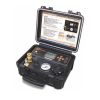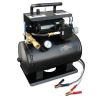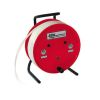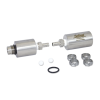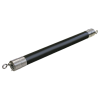Solinst Model 408 Double Valve Pumps
Features
- Positive displacement, gas drive pump provides consistent samples with excellent VOC results
- Pneumatic drive pumps are well suited for pumping contaminant liquids
- No bladder replacement is required, and provides higher pumping rates than bladder pumps
- Expedited repair and warranty service
- Lifetime technical support
- More
Overview
The Solinst Model 408 stainless steel double valve pump (DVP) is a pneumatic drive pump that allows consistent, high-quality samples. No bladder replacement is required, and the Double Valve Pump provides higher pumping rates than the Solinst Integra Bladder Pump. There is a selection of sizes and materials, variable flow rates, and it is field serviceable.
Applications
The DVP is suitable for low-flow or regular-flow sampling. The stainless steel pumps can operate to depths of 500 ft (150 m), and the PVC Double-Valve Pump can operate to depths of 100 ft (30 m). Everything is easily accessible, replaceable, and interchangeable. All components can be cleaned with mild detergent or non-phosphate soap. Pumps are not damaged by operation in sediment-laden water or dry pumping conditions.
Mechanics
Flow rates vary with the pump's depth below the surface, the depth below water level, the size of the drive and sample tubing, the drive and vent cycle times, the gas pressure applied, the aquifer recharge, and the size of the pump body.
- Solinst Model 408 Stainless Steel Double Valve Pump Specifications
- Solinst Model 408 Stainless Steel Double Valve Pump Operating Principles
- Solinst Model 408 5/8" Stainless Steel Double Valve Pump Operating Instructions
- Solinst Model 408 1.66" Stainless Steel Double Valve Pump Operating Instructions
In The News
Solinst groundwater samplers: Versatile options for a variety of applications
Groundwater sampling can be a challenging task that requires different tools for different applications. Solinst groundwater samplers offer the capability to obtain commonly needed representative samples of groundwater using different approaches of water withdrawal. Solinst’s 425 Discrete Interval Sampler uses passive sampling to grab water from a specific depth. The 407 Bladder Pump enables continuous airtight low flow sampling. The 408 Double Valve Pump can continuously sample at variable rates. “One sampler isn’t necessarily going to be for every site,” said Randy Blackburn, Solinst product manager. Each has different means of fluid sampling. The 425 sampler relies on a manual air pump that pressurizes the sampler based on the water depth.
Read MoreScience for Science’s Sake: Monitoring Ocean Energy Availability and Gulf Stream Dynamics
Scientific research often begins with a question, sometimes driven by a specific goal or application, but many scientists believe in science for science’s sake. Marine environments and physical dynamics like the Gulf Stream are popular fields of research due to their complexity and importance, presenting a unique opportunity to learn more about previously unexplored phenomena. Environmental researchers, in particular, see the value in these ecosystems, but many also grew up with a passion for the natural world, and choosing a field that allows them to interact with and learn about the environment around us is an easy choice.
Read MoreResearch in the Reserve: Promoting Interdisciplinary Conservation at the Great Bay National Estuarine Research Reserve
On an early winter day in 1973, a helicopter buzzed over Durham, New Hampshire, just a few miles from the Atlantic Ocean. One of the helicopter’s guests, oil magnate Aristotle Onassis, owner of Olympic Refining, looked east of town and saw what he hoped would become the world’s largest oil refinery. Instead, he saw the Great Bay; thousands of acres of green coastal forest, mud flats, salt marshes, and estuarine tidal waters stretching over the land toward New Hampshire's small Eastern coastline. Onassis likely also saw a group of Durham residents staked out on the bay’s coast, ready for him to pass overhead. While out of place in the natural setting, an obvious message was spelled out in red paper: “Not Here.
Read More
















